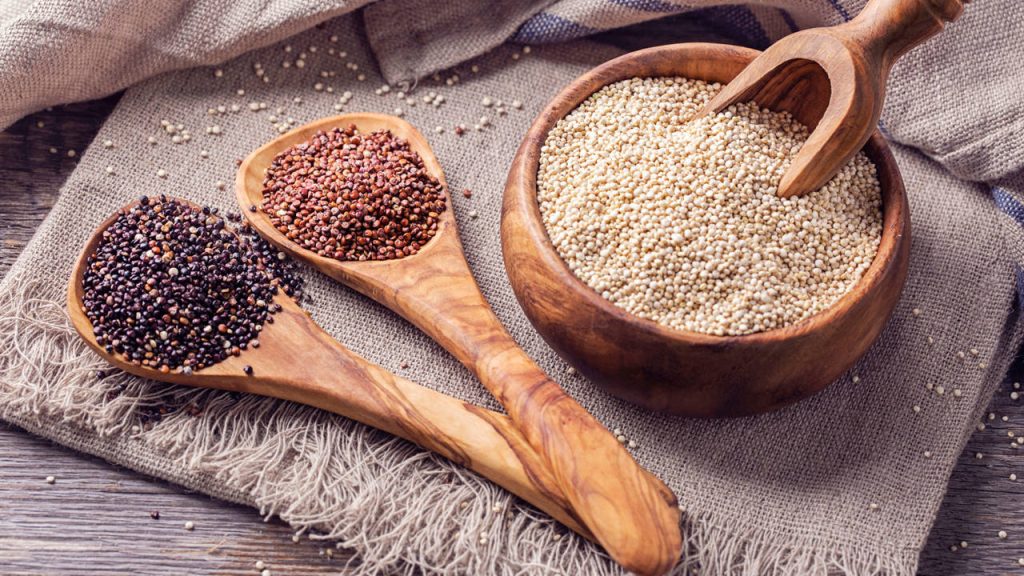If quinoa has a reputation as a superfood, it’s because it deserves it, but can this nutritious pseudo cereal really help you increase your omega-3 levels even more than salmon?

In recent weeks various media and food websites have been echoing a statement about quinoa that has been circulating on the internet for some time and that would make quinoa even more nutritionally attractive than it already is, attributing an amount of omega-3 fatty acids up to five times higher than that of salmon and other oily fish.
The headlines appealing to a superfood or super cereal that has much more omega-3 than salmon are very exciting, and quinoa is undoubtedly a grain with a healthy nutritional composition and many properties, but is quinoa really rich in omega-3? How much omega-3 does quinoa really provide? Is there any cereal or superfood that outperforms salmon in such proportion?
LET’S START AT THE BEGINNING
First you have to know that omega-3 fatty acids are a type of polyunsaturated fatty acids and that there are different types of omega-3, among which three stand out: alpha-linolenic acid (ALA), which is found in some seeds and vegetable oils, and EPA (Eicosapentaenoic acid) and DHA (docosahexaenoic acid) fatty acids., which are concentrated in oily fish, some microalgae, the mother’s milk and meat of some grass-fed animals.
ALA is considered an essential fatty acid, that is, we must consume it through food, because the body is not able to manufacture it by itself.
EPA and DHA can be synthesized by the body from ALA, but only in small amounts.
Omega-3s are essential for the formation of cell membranes, for the relaxation of arterial walls and to regulate inflammation, among other functions, and their consumption has been associated with the prevention of cardiovascular diseases, among many other benefits.
Since the omega-3s most easily usable by the body are found in animal sources, such as oily fish, knowing which plant foods can provide omega-3 to the body is important, both for people who follow a vegetarian diet and for those who want to reduce their consumption of animal protein.
Comparing a food like quinoa with fish for its omega-3 contributions can generate a lot of confusion, so let’s see what, if any, is really in that quinoa is so rich in omega-3.
DOES QUINOA PROVIDE FIVE TIMES MORE OMEGA-3 THAN SALMON?
Unfortunately, everything indicates that it does not: it is not true that quinoa provides more omega-3 than salmon. So why is that said? The claim that quinoa quintuples the omega-3 contribution of salmon comes from attributing to this pseudocereal a contribution of 8.35 g of omega-3 per 100 grams.
However, although quinoa provides some alpha-linolenic acid, the type of omega-3 fatty acid found in plant foods, in the bases of nutritional composition of reference the amount indicated is much lower and is far from providing more omega-3 than salmon.
Some sources attribute the figure of 8.35 g of omega-3 in quinoa to a report by the FAO (Food and Agriculture Organization of the United Nations), but the FAO neither in its analysis of quinoa, where it reviews the figures of several Latin American studies, nor in its summary of the nutritional value of quinoa, it gives values that resemble it. It highlights the high fat content of quinoa compared to other cereals, located around 6.3 g of total fats, but only 50% of these (that is, just over 3 g) would be polyunsaturated and, among them, omega-6 would predominate, followed to a lesser extent by omega-9 and omega-3.
It should also be borne in mind that in oily fish, which is attributed a contribution of about 2.5 g of omega-3, what we find mainly is EPA (Eicosapentaenoic acid) and DHA (docosahexaenoic acid), which the body does not need to transform to use in its favor.
These forms of omega-3, EPA and DHA, are the bioactive forms, while when we take ALA, present in plant foods, the body has to transform it into DHA to take advantage of it, and it does so only partially.
“Most of the ALA we ingest is stored in the form of fat, a small part is oxidized and another even smaller part is converted into EPA and DHA, “explains Lucía Martínez, dietitian-nutritionist specialized in clinical nutrition in vegan food and author of Vegetarians with science, among other nutrition works.
That does not mean that we cannot get our omega-3 from plant foods: there are plant foods that provide a good amount of alpha-linolenic acid that the body can transform into active omega-3, but for the purposes of what the body takes advantage of we cannot equate the contributions of ALA of a plant food with those of EPA or DHA from fish.
SO HOW MUCH OMEGA-3 DOES QUINOA REALLY HAVE?
According to the USDA (United States Department of Agriculture) database, which is often taken as a reference, raw quinoa would contain 0.26 g of alpha-linolenic acid (ALA), about thirty times less than what has been attributed to it, and only 0.085 g if we talk about 100 g of cooked quinoa, a hundred times less!
In addition, many scientific studies have looked at quinoa and analyze its composition, even comparing different cultivars and harvest years. A review published in Nutrients in 2022 collected figures from different previous studies that confirm similar figures in raw quinoa.
We might wonder what percentage of ALA our body transforms into EPA and DHA, but there is no simple answer. According to Lucía Martínez, we don’t know more about the conversion of ALA into DHA than we know. “We know that it occurs mostly in the liver, but its efficacy can be variable, as the same dose does not always result in the same response.”
IS THE OMEGA-3 IN QUINOA TOO MUCH OR TOO LITTLE?
If we compare quinoa with plant foods richer in alpha-linolenic acid, this pseudocereal is well below the most prominent foods, such as flax seeds (22.8 g), chia (17.8 g), walnuts (9 g) or rapeseed oil (9.1 g).
It is true that these foods are more caloric and we take them in smaller quantities, but it would be necessary to take more than 400 grams of raw quinoa to get the same amount of ALA that we would get with a teaspoon of 5 grams of flax seeds, or about 340 g of raw quinoa to achieve the contributions of 5 g of chia. “We cannot say that quinoa is a remarkable source of omega-3,” confirms Lucía Martínez.
Even so, the small amounts of ALA in plant foods add up throughout the day if we incorporate them into our diet. And the contribution of quinoa is close to the contributions of foods such as edamame beans (0.3 g), avocado (0.11 g) or Brussels sprouts (0.09 g), which are consumed in similar portions and, together, contribute to reinforce the contributions of ALA.
According to experts, the minimum recommended daily amounts of ALA for the European population would be around 1.1 g per day for women and 1.6 g per day for men. A serving of about 60 grams of quinoa (raw weight) would contribute to obtaining about 10% of the necessary ALA. With about 14 g of walnuts or just under a teaspoon of flaxseed oil, we would cover them completely.
SO, WHAT DOES QUINOA CONTRIBUTE AND WHY IS IT CONSIDERED SO HEALTHY?
Quinoa is a pseudocereal with a high concentration of nutrients that stands out especially for its high content of proteins of high biological value (13% of its weight) and minerals such as iron, magnesium, potassium or zinc. It also provides B vitamins, in particular B2 and B3.
Its fat intake is relatively high compared to other cereals, as it is around 6%, of which its high percentage of polyunsaturated fats stands out, which could have led to confusion about its extraordinary richness in omega-3.
Beyond its nutrients, quinoa has the advantage over other cereals such as wheat, rye or barley that it does not contain gluten, so it is suitable for celiac people, and is also digested well.
It also does not require pesticides or fertilizers for its cultivation, which has made it a highly appreciated food in those who seek to have a healthy and more ecological diet.
IS THERE A PLANT FOOD THAT PROVIDES AS MUCH OMEGA-3 AS SALMON?
The only plant-based foods that contain significant amounts of EPA and DHA, the omega-3 fatty acids present in fish, are some microalgae, which are used in omega-3 supplements for vegetarians, although there is no consensus that this is necessary. All other plant foods contain ALA, which the body transforms only partially into EPA and DHA, and only in significant amounts into some seeds and vegetable oils.
According to dietitian-nutritionist Lucía Martínez, it has been seen that blood levels of EPA and DHA fatty acids are somewhat lower in people who do not consume oily fish, but it has not been shown that these small differences are harmful. On the other hand, it seems that the conversion rate of ALA to DHA increases in these people.
To get enough omega-3 fatty acids, nutritionists’ recommendation for vegetarians or non-fish eaters focuses on three key aspects:
- Reduce the consumption of omega-6, which competes for the metabolization pathway with omega-3.
- Ensure the supply of ALA with foods such as flax or walnuts to promote its conversion to DHA.
- In cases where it is considered necessary, supplementation with DHA may also be advised, although there is no consensus among experts.








